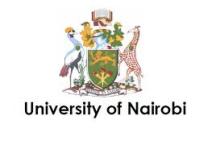Resource information
This study was conducted in the northern part of Kenya, in Kakuma division, Turkana district. Kakuma is a semi-
arid area under nomadic pastoralism as the main activity. The presence of a refugee camp has attracted many people from within
the Turkana community and also the outside community. The study aimed at documenting the effects of emergent land use
changes on vegetation resources and the socio-economic environment in Kakuma. Data on vegetation density and cover was
collected. Socio-economic data was collected from the local Turkana population and the settlement camp. The data was analysed
using SPSS computer package and descriptive statistics. There was a significant difference (P<0.05) in vegetation cover and
density with increasing distance away from the settlement camp. The mean tree crown cover was low near the settlement camp
(6.2%) but high away from the settlement camp (57.7%). Mean tree density was high near the settlement camp (13 individuals/
100m
2
). Shrub crown cover was low (0.9%) in the areas that had settlements. The need for fencing and building materials was the
main cause of low shrub cover. The density of the shrub species generally increased as one moved away from the settlement camp
(17 individuals/ 16m
2
). Herb species cover and density was high near the settlement camp(68% and 202 individuals/ 1m
2
respectively)
but this comprised mostly of species unpalatable to livestock like
Tribulus terrestris
and
Portulaca oleraceae.
The study revealed
that droughts and livestock raids in the previous years had set in motion social and ecological changes. The loss of livestock
through raids and droughts encouraged sedenterization. This affected the cultural patterns and has had an effect on the rangela
nd
condition. Lack of mobility concentrated livestock in specific areas, thus depleting the forage resources and creating conditio
ns for
soil erosion. Trading activities between the refugees and the Turkana had both positive and negative impact on the economic,
social and cultural setup of the local community. The increase in population around Kakuma and the settlement camp has set in
motion changes that have affected vegetation and social structures. The immediate social and economic returns from the exploita
tion
of resources have overridden the long-term benefits. In regard to this there is a need for education on the impacts, both short
-term
and long-term, of the various activities on the vegetation, livestock resources and also the pastoral lifesty


